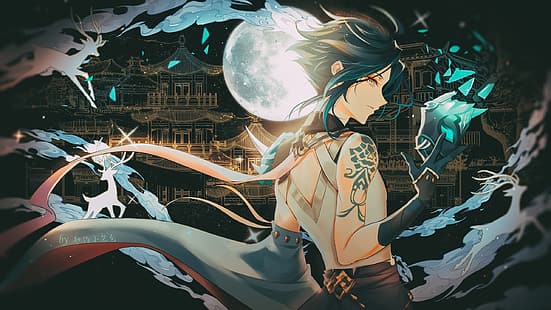Các vị thần Hindu


| Một phần của loạt bài về |
| Ấn Độ giáo |
|---|
 |
Các vị thần Hindu là các nam thần và nữ thần trong Ấn Độ giáo. Các thuật ngữ và văn bia cho các vị thần trong các truyền thống của Ấn Độ giáo là khác nhau, với các tên thần khác nhau bao gồm Deva, Devi, Ishvara, Ishvari, Bhagavān và Bhagavati.[1][2] [note 1]
Các vị thần của Ấn Độ giáo đã phát triển từ thời kỳ Vệ đà (thiên niên kỷ thứ 2 TCN) qua thời trung cổ (thiên niên kỷ thứ 1), theo khu vực ở Nepal, Ấn Độ và Đông Nam Á, và qua các truyền thống đa dạng của Ấn Độ giáo.[3][4] Các vị thần Hindu khái niệm khác nhau từ một vị thần cá nhân như trong Yoga học của triết học Hindu,[5][6] đến 33 vị thần Vệ Đà,[7] đến hàng trăm thần Puranas của Ấn Độ giáo.[8] Minh họa của các vị thần lớn bao gồm Parvati, Vishnu, Sri (Lakshmi), Shiva, Sati, Brahma và Saraswati. Những vị thần này có những tính cách riêng biệt và phức tạp, nhưng thường được xem là những khía cạnh của cùng một Thực tại tối thượng được gọi là Brahman.[9] [note 2] Từ thời cổ đại, ý tưởng về sự tương đương đã được ấp ủ cho tất cả người Ấn giáo, trong các văn bản của nó và trong tác phẩm điêu khắc thiên niên kỷ thứ 1 với các khái niệm như Harihara (Half Vishnu, Half Shiva) [10] và Ardhanārīshvara (một nửa Shiva, một nửa Parvati),[11] với những huyền thoại và đền thờ kết hợp chúng lại với nhau, tuyên bố chúng giống nhau.[12][13][14] Các vị thần lớn đã truyền cảm hứng cho các truyền thống Ấn Độ giáo của riêng họ, chẳng hạn như Vaishnavism, Shaivism và Shaktism, nhưng với thần thoại chung, ngữ pháp nghi lễ, thần học, tiên đề và đa thần giáo.[15][16][17] Một số truyền thống Hindu, như Smartism từ thiên niên kỷ AD giữa 1st, đã bao gồm nhiều vị thần lớn như biểu hiện của Saguna Brahman, và như là một phương tiện để thực hiện các Nirguna Brahman.[18][19][20]
Các vị thần Hindu được đại diện với các biểu tượng và anicons khác nhau, trong các bức tranh và tác phẩm điêu khắc, được gọi là Murtis và Pratimas.[21][22] Một số truyền thống Ấn Độ giáo, như Charvakas cổ đại, đã bác bỏ tất cả các vị thần và khái niệm về thần hoặc nữ thần,[23][24][25] trong khi các phong trào thời thuộc địa Anh thế kỷ 19 như Arya Samaj và Brahmo Samaj từ chối các vị thần và chấp nhận các khái niệm độc thần tương tự như các tôn giáo Áp-ra-ham.[26][27] Các vị thần Hindu đã được chuyển qua trong các tôn giáo khác như Jaina giáo,[28] và ở các khu vực bên ngoài Ấn Độ, như chủ yếu là Phật giáo Thái Lan và Nhật Bản, nơi họ tiếp tục được tôn kính trong các đền chùa hoặc nghệ thuật khu vực.[29][30][31]
Trong các văn bản Ấn Độ giáo thời cổ đại và trung cổ, cơ thể con người được mô tả như một ngôi đền,[32][33] và các vị thần được mô tả là những phần cư trú bên trong nó, trong khi Brahman (Hiện thực tuyệt đối, Thiên Chúa) [18][34] được mô tả là giống nhau, hoặc có bản chất tương tự, như Atman (bản thân, linh hồn), mà người Ấn giáo tin là vĩnh cửu và trong mỗi sinh vật.[35][36][37] Các vị thần trong Ấn Độ giáo cũng đa dạng như truyền thống của nó, và một người theo đạo Hindu có thể chọn là đa thần, phiếm thần, độc thần, độc đạo, bất khả tri, vô thần hoặc nhân văn.[38][39]
Ghi chú
[sửa | sửa mã nguồn]- ^ For translation of deva in singular noun form as "a deity, god", and in plural form as "the gods" or "the heavenly or shining ones", see: Monier-Williams 2001, tr. 492 and Renou 1964, tr. 55
- ^ [a] Hark, Lisa; DeLisser, Horace (2011). Achieving Cultural Competency. John Wiley & Sons.
Three gods, Brahma, Vishnu, and Shiva, and other deities are considered manifestations of and are worshipped as incarnations of Brahman.
[b] Toropov & Buckles 2011: The members of various Hindu sects worship a dizzying number of specific deities and follow innumerable rites in honor of specific gods. Because this is Hinduism, however, its practitioners see the profusion of forms and practices as expressions of the same unchanging reality. The panoply of deities are understood by believers as symbols for a single transcendent reality.
[d] Orlando O. Espín, James B. Nickoloff (2007). An Introductory Dictionary of Theology and Religious Studies. Liturgical Press.While Hindus believe in many devas, many are monotheistic to the extent that they will recognise only one Supreme Being, a God or Goddess who is the source and ruler of the devas.
Tham khảo
[sửa | sửa mã nguồn]- ^ Radhakrishnan and Moore (1967, Reprinted 1989), A Source Book in Indian Philosophy, Princeton University Press, ISBN 978-0691019581, pages 37-39, 401-403, 498-503
- ^ Mircea Eliade (2009), Yoga: Immortality and Freedom, Princeton University Press, ISBN 978-0691142036, pages 73-76
- ^ Nicholas Gier (2000), Spiritual Titanism: Indian, Chinese, and Western Perspectives, State University of New York Press, ISBN 978-0791445280, pages 59-76
- ^ Jeaneane D. Fowler (2012), The Bhagavad Gita, Sussex Academic Press, ISBN 978-1845193461, pages 253-262
- ^ Renou 1964
- ^ Mike Burley (2012), Classical Samkhya and Yoga - An Indian Metaphysics of Experience, Routledge, ISBN 978-0415648875, page 39-41;
Lloyd Pflueger, Person Purity and Power in Yogasutra, in Theory and Practice of Yoga (Editor: Knut Jacobsen), Motilal Banarsidass, ISBN 978-8120832329, pages 38-39;
Kovoor T. Behanan (2002), Yoga: Its Scientific Basis, Dover, ISBN 978-0486417929, pages 56-58 - ^ George Williams (2008), A Handbook of Hindu Mythology, Oxford University Press, ISBN 978-0195332612, pages 90, 112
- ^ Sanjukta Gupta (2013), Lakṣmī Tantra: A Pāñcarātra Text, Motilal Banarsidass, ISBN 978-8120817357, page 166
- ^ Knut Jacobsen (2008), Theory and Practice of Yoga: 'Essays in Honour of Gerald James Larson, Motilal Banarsidass, ISBN 978-8120832329, pages 77-78
- ^ David Leeming (2001), A Dictionary of Asian Mythology, Oxford University Press, ISBN 978-0195120530, page 67
- ^ Ellen Goldberg (2002), The Lord who is half woman: Ardhanārīśvara in Indian and feminist perspective, State University of New York Press, ISBN 0-791453251, pages 1–4
- ^ TA Gopinatha Rao (1993), Elements of Hindu Iconography, Vol. 2, Motilal Banarsidass, ISBN 978-8120808775, pages 334-335
- ^ Fred Kleiner (2012), Gardner's Art through the Ages: A Global History, Cengage, ISBN 978-0495915423, pages 443-444
- ^ Cynthia Packert Atherton (1997), The Sculpture of Early Medieval Rajasthan, Brill, ISBN 978-9004107892, pages 42-46
- ^ Lance Nelson (2007), An Introductory Dictionary of Theology and Religious Studies (Editors: Orlando O. Espín, James B. Nickoloff), Liturgical Press, ISBN 978-0814658567, pages 562-563
- ^ Julius J. Lipner (2009), Hindus: Their Religious Beliefs and Practices, 2nd Edition, Routledge, ISBN 978-0-415-45677-7, pages 371-375
- ^ Frazier, Jessica (2011). The Continuum Companion to Hindu Studies. London: Continuum. tr. 1–15. ISBN 978-0-8264-9966-0.
- ^ a b For dualism school of Hinduism, see: Francis X. Clooney (2010), Hindu God, Christian God: How Reason Helps Break Down the Boundaries between Religions, Oxford University Press, ISBN 978-0199738724, pages 51-58, 111-115;
For monist school of Hinduism, see: B. Martinez-Bedard (2006), Types of Causes in Aristotle and Sankara, Thesis - Department of Religious Studies (Advisors: Kathryn McClymond and Sandra Dwyer), Georgia State University, pages 18-35 Lỗi chú thích: Thẻ<ref>không hợp lệ: tên “fxclooney” được định rõ nhiều lần, mỗi lần có nội dung khác - ^ Michael Myers (2000), Brahman: A Comparative Theology, Routledge, ISBN 978-0700712571, pages 124-127
- ^ Thomas Padiyath (2014), The Metaphysics of Becoming, De Gruyter, ISBN 978-3110342550, pages 155-157
- ^ "pratima (Hinduism)". Encyclopædia Britannica. Truy cập ngày 21 tháng 8 năm 2011.
- ^ PK Acharya, An Encyclopedia of Hindu Architecture, Oxford University Press, page 426
- ^ V. V. Raman (2012), Hinduism and Science: Some Reflections, Zygon - Journal of Religion and Science, 47(3): 549–574, Quote (page 557): "Aside from nontheistic schools like the Samkhya, there have also been explicitly atheistic schools in the Hindu tradition. One virulently anti-supernatural system is/was the so-called Charvaka school."
- ^ John Clayton (2010), Religions, Reasons and Gods: Essays in Cross-cultural Philosophy of Religion, Cambridge University Press, ISBN 978-0521126274, page 150
- ^ A Goel (1984), Indian philosophy: Nyāya-Vaiśeṣika and modern science, Sterling, ISBN 978-0865902787, pages 149-151;
R. Collins (2000), The Sociology of Philosophies, Harvard University Press, ISBN 978-0674001879, page 836 - ^ Naidoo, Thillayvel (1982). The Arya Samaj Movement in South Africa. Motilal Banarsidass. tr. 158. ISBN 81-208-0769-3.
- ^ Glyn Richards (1990), The World's Religions: The Religions of Asia (Editor: Friedhelm Hardy), Routledge, ISBN 978-0415058155, pages 173-176
- ^ John E. Cort (1998), Open Boundaries: Jain Communities and Cultures in Indian History, State University of New York Press, ISBN 978-0791437865, pages 218-220
- ^ Hajime Nakamura (1998), A Comparative History of Ideas, Motilal Banarsidass, ISBN 978-8120810044, pages 26-33
- ^ Ellen London (2008), Thailand Condensed: 2,000 Years of History & Culture, Marshall Cavendish, ISBN 978-9812615206, page 74
- ^ Trudy Ring et al. (1996), International Dictionary of Historic Places: Asia and Oceania, Routledge, ISBN 978-1884964046, page 692
- ^ Jean Holm and John Bowker (1998), Sacred Place, Bloomsbury Academic, ISBN 978-0826453037, pages 76-78
- ^ Michael Coogan (2003), The Illustrated Guide to World Religions, Oxford University Press, ISBN 978-0195219975, page 149
- ^ World Religions. Winona, MN: Saint Mary's Press. 2003. ISBN 978-0-88489-725-5.
{{Chú thích sách}}: Đã bỏ qua tham số không rõ|authors=(trợ giúp) - ^ Monier-Williams 1974
- ^ John Koller (2012), Routledge Companion to Philosophy of Religion (Editors: Chad Meister, Paul Copan), Routledge, ISBN 978-0415782944, pages 99-107
- ^ R Prasad (2009), A Historical-developmental Study of Classical Indian Philosophy of Morals, Concept Publishing, ISBN 978-8180695957, pages 345-347
- ^ Lester Kurtz (ed.), Encyclopedia of Violence, Peace and Conflict, ISBN 978-0123695031, Academic Press, 2008
- ^ M. K. Gandhi, The Essence of Hindu, Editor: V. B. Kher, Navajivan Publishing, see page 3; According to Gandhi, "a man may not believe in God and still call himself a Hindu."
 GIẢM
15%
GIẢM
15%
 GIẢM
37%
GIẢM
37%
 GIẢM
16%
GIẢM
16%
 GIẢM
31%
GIẢM
31%
 GIẢM
27%
GIẢM
27%




